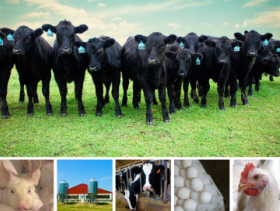



Study: Economic Ripple Effect of Livestock Operations in Indiana
ANALYSIS - If you've driven through the US state of Indiana, you'll have seen lots of corn and soybean fields. It’s no surprise that it ranks in the top 10 US agricultural states, but what is surprising is that Indiana livestock operations are seeing significant growth and are outpacing the US as a whole. New research examining the impact of growing Indiana’s animal agriculture industries, funded by the Indiana Soybean Alliance, has shown that Indiana communities should consider animal agriculture as a strategic option when thinking about economic development and community growth.
New research examining the impact of growing Indiana’s animal agriculture industries, funded by the Indiana Soybean Alliance, has shown that Indiana communities should consider animal agriculture as a strategic option when thinking about economic development and community growth.
The new regional economic study, conducted by the Indiana Business Research Center, Kelley School of Business at Indiana University, considers both the direct impact of animal agriculture as well as anticipated ripple, or multiplier, effects within economic systems.
“Not only do livestock industries generate billions of dollars in sales each year, their activities also trigger economic ripple effects that cascade throughout our Indiana economy,” said Tom Griffiths, Indiana Soybean Alliance Chairman and farmer from Kendallville, Ind. “At every step, jobs, taxes and revenue are added to the local economy. When combined, it’s important to consider the full economic impact of animal agriculture.”
The report also examines hypothetical scenarios for the opening of new animal agriculture facilities, and looks at the economic effects that these scenarios would have in each Indiana region in terms of employment, income and total sales. Researchers conclude that growing these industries will boost the state’s position among the nation’s leaders and expand economic opportunity in Indiana.
Each industry and region has its own unique multipliers based on differences in supply chain requirements and the balance between labor and material inputs needed to bring their products or services to market.
Poultry and egg production, for instance, has a very large employment multiplier because this industry tends to be highly production input-intensive, meaning that this industry engages a very long supply chain while producing its products with relatively few direct employees. The employment multiplier for this industry suggests that every 100 workers involved with poultry and egg production supports an estimated 639 jobs in other industries in Indiana.
The study also found that a new hog farm with $2.0 million in direct sales can be expected to generate total sales impacts between $2.72 million to $3.15 million in Indiana’s nine regions. This new economic activity will support between 24 and 28 total new jobs and an additional $508,000 to $795,000 in additional household income in each of these areas.
The research shows that expanding Indiana animal agriculture will generate significant economic ripple effects — what the Indiana Soybean Alliance calls the ‘Ag Effect.’
“The goal of this analysis was to focus on how growing these industries will impact the state’s regional economies moving forward. We know Indiana has recently seen livestock sector growth,” said Griffiths. “Efforts to further expand animal agriculture will not only strengthen these industries directly, but will also generate important economic ripple effects in Indiana’s regions. So, animal agriculture growth will be an important future economic indicator for Indiana and its regions.”
To read the complete study: The Economic Impact of Animal Agriculture in Indiana Regions: An Analysis of Existing and Prospective Producers, go to farmersdeliver.com/impactreport.









